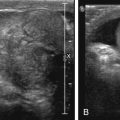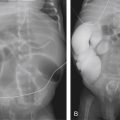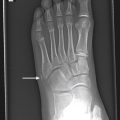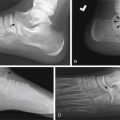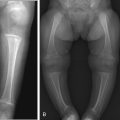Respiratory distress is one of the most common complaints seen in the pediatric urgent care or emergency department setting. Clinically, respiratory distress is characterized by tachypnea, increased respiratory effort, and poor oxygenation. Radiographs remain the primary imaging modality for evaluation of the pediatric chest because of low cost and easy availability.
A full understanding of normal anatomy on chest radiograph is necessary to recognize important pathology in the setting of respiratory distress. Thus the first portion of this chapter will focus on the normal appearance of fundamental anatomy in children of different ages.
The second portion of this chapter will focus on an organized differential diagnosis of the most common causes of respiratory distress by age, highlighting important diagnostic findings on chest radiographs. Other modalities such as ultrasound, computed tomography (CT), and magnetic resonance imaging (MRI) will be briefly mentioned.
Basic Chest Radiograph Interpretation
As with all radiology, approaching the pediatric chest radiograph with a systematic search pattern ensures that important structures are seen and evaluated on each and every study. A common search pattern for chest radiographs is the “ABCDEFGH” checklist. We will use this model to review the fundamentals of pediatric chest radiograph interpretation with a special emphasis on the normal appearance of structures by age.
“A” for “Airway”
A careful evaluation of the trachea should be performed on both frontal and lateral chest radiographs. On the frontal view, normal “shouldering” of the subglottic trachea is seen at the inferior margin of the vocal folds ( Fig. 1.1 ). The intrathoracic trachea is slightly shifted into the right mediastinum in the setting of a normal left aortic arch.

Special attention should be given to the normal appearance of the proximal thoracic trachea in expiration. In the infant and young toddler, the cervical trachea is quite mobile and may buckle at the thoracic inlet on expiration ( Fig. 1.2 ).

“B” for “Bones”
As with adult chest radiographs, evaluation of the bones in the chest can add important information regarding patient position and respiratory effort.
In a well-aligned posteroanterior (PA) or anteroposterior (AP) chest radiograph, the spinous processes of the thoracic vertebral bodies should form a vertical line down the center of the thoracic spine, and the medial ends of the clavicles should be equidistant from the center line of the spine.
Lung inflation can be determined by counting the number of posterior ribs ( Fig. 1.3 ). In the newborn, 8 to 9 posterior ribs should be visualized above the associated hemidiaphragm. In toddlers and young children, normal pulmonary inflation is 8 to 10 ribs expansion. In older children and adolescents, normal pulmonary inflation is 10 to 12 ribs expansion. Others use anterior ribs, typically 6 anterior ribs completely above the hemidiaphragm contour.

During this step of chest radiograph evaluation, bones of the thorax should be carefully assessed for fracture. This is especially important in infants and young children because posterior and anterior rib fractures, scapula fractures, or humeral fractures may be the first and most subtle signs of nonaccidental trauma ( Fig. 1.4 ).

A complete survey of the chest radiograph in children should include evaluation for possible congenital anomalies of the thoracic and upper lumbar spine, ribs, and proximal long bones of the upper extremities ( Fig. 1.5 ). By systematically screening for these abnormalities, an astute radiologist may be the first to suggest underlying genetic syndromes, such as VACTERL (vertebral defects, anal atresia, cardiac defects, tracheoesophageal fistula, renal anomalies, and limb abnormalities).

“C” for “Cardiac” and Mediastinal Structures
Evaluation of the cardiac silhouette should include evaluation of overall cardiac size and gross structure of the heart and mediastinum.
The appearance and appropriate size of the cardiac silhouette on chest radiograph changes with age ( Fig. 1.6 ). Neonates and infants have a more barrel-shaped chest that is equal in transverse and AP dimensions, and the normal cardiac silhouette may take up to 50% (infants) to 60% (neonates) of the transverse thoracic diameter. As children grow, their chest shape changes, and by age 10 to 13 years the normal cardiac silhouette appears similar to that seen in adults, taking up between 30% and 50% of the transverse thoracic diameter.

Gross structures of the heart and great vessels should be evaluated on every pediatric chest radiograph, including the aortic arch, pulmonary artery, and specific cardiac chambers ( Fig. 1.7 ).

Evaluation of aortic arch sidedness is an important exercise in interpretation of pediatric chest radiograph. The normal left-sided aortic arch is a result of normal cardiac looping during embryology. Presence of a right-sided aortic arch may be the first subtle clue of under lying congenital heart disease. The normal left-sided aortic arch should opacify the left superior mediastinum with gentle rightward shift of the adjacent trachea. In contrast, a right-sided aortic arch will result in gentle leftward shift of the trachea ( Fig. 1.8 ). The descending aorta sidedness may sometimes be confirmed inferiorly toward the level of the diaphragm.

Normal appearance of the mediastinum also varies considerably with age because of variable size of the thymus (see Fig. 1.6 ). The thymus is most prominent in children younger than 3 years but can occasionally be identified on chest radiographs in children up to age 10 to 12 years. On radiograph, the normal thymus has similar density to the adjacent heart and vascular structures, has soft contours, and does not compress adjacent structures ( Fig. 1.9 ). Full understanding of these imaging features allows the astute radiologist to differentiate normal thymus from mediastinal pathology.

Patients under considerable physiological stress may have decreased thymic size and changes in configuration. Once stress has subsided, the thymus can grow up to 50% of original size, a phenomenon known as “thymic rebound.”
“D” for “Diaphragm”
The diaphragm should be evaluated for position, shape, and symmetry. There is minimal variation in appearance of the hemidiaphragms during childhood (see Fig. 1.2 ).
The right hemidiaphragm is often slightly higher than the left because of mass effect from the underlying liver. Otherwise, the hemidiaphragms should be symmetrical in location and should be able to be outlined easily. Marked asymmetry of diaphragm position should prompt further investigation into underlying pulmonary pathology or diaphragm function ( Fig. 1.10 ). Inability to outline the hemidiaphragm raises concern for adjacent abnormality, such as atelectasis, pneumonia, mass, or pleural effusion.

“E” for “Effusions”
Pleural effusions may be large and obvious or small and subtle. On upright chest radiograph, effusions are seen layering dependently in the costophrenic sulcus. However, many chest radiographs in small children are performed in the supine position, and effusions will layer along the posterior chest in the pleural cavity and may appear as a subtle asymmetrical density ( Fig. 1.11 ).

“F” for Lung “Fields”
A common colloquial term for the pulmonary parenchyma is “lung fields.” In chest radiograph evaluation, it is conventional to divide the “lung fields” into three zones: upper, middle, and lower. Lung zones in the right and left chest are compared for uniform aeration and any evidence of asymmetrical opacity. If the lungs appear asymmetrical, it should be determined whether this finding can be explained by asymmetry of normal anatomic structures, technical factors such as rotation, or underlying lung pathology.
The major and minor fissures are not routinely seen against the background normally aerated lung. However, knowledge of the expected position of the pulmonary fissures may assist in defining underlying pulmonary pathology ( Fig. 1.12 ).

Lung markings should be seen to the chest wall. If the visceral pleura is visible, a pneumothorax should be suspected. Again, many chest radiographs in young children are performed in the supine position, and in this position extrapleural gas may move to the anterior or subpulmonic pleural space ( Fig. 1.13 ).

“G” for “Gastric” Bubble and “Gas” Pattern
Gas within the stomach is commonly seen on chest radiograph. In pediatric patients, evaluation of gastric sidedness is important in conjunction with aortic arch sidedness to detect underlying heterotaxy or situs inversus ( Fig. 1.14 ).

Gas-filled loops of small and large bowel in the upper abdomen are also frequently seen and should be evaluated for size and normal appearance. Free intraabdominal gas can be seen particularly as a subdiaphragmatic lucent crescent on upright chest radiographs.
“H” for “Hilum”
The pulmonary hila, or roots, are complicated structures made up of major bronchi, pulmonary arteries and veins, and hilar lymph nodes. Routine chest radiograph assessment involves evaluation of the hilar structures for normal size, density, and position.
In pediatric patients, careful attention should be made to the relative size of paired bronchovascular structures in the hila. Pulmonary vessels and bronchi should be of similar size on the normal chest radiograph ( Fig. 1.15 ). Difference in size of the pulmonary vessels and bronchi may signal underlying pathology, such as pulmonary vascular overcirculation or bronchiectasis and air trapping.

Differential Diagnosis of Respiratory Distress by Age
The differential diagnosis of respiratory distress is broad and variable by age in the pediatric population. Clinical history and careful physical examination can be extremely helpful in targeting diagnostic evaluation.
Toddler and Young Child
Differential diagnosis of respiratory distress in the toddler and young child includes airways disease, infection, or aspirated foreign body.
Airways
Respiratory distress may occur as the result of an upper or lower airway process. Abnormal breath sounds are frequently associated with respiratory distress in this age group, and the quality of abnormal breath sounds may help target the source of airway pathology.
Upper Airway Obstruction
Stertor and stridor are more frequently associated with upper airway obstruction. These clinical findings are best evaluated with radiographs of the soft tissues of the neck (see Chapter 26 ). Wheezing, grunting, rales, and crackles are more frequently seen in lower airway disease and should prompt imaging evaluation with chest radiograph ( Table 1.1 ).
| Abnormal Breath Sounds | Definition | Cause | Imaging |
|---|---|---|---|
| Stertor |
|
|
|
|
|
|
|
|
|
|
|
|
| Lower airways | Chest x-ray, two views (frontal and lateral) |
Lower Airway Structural Abnormality
The main lower airway structural abnormality that may be identified on radiographs is tracheal compression caused by a congenital vascular ring or pulmonary artery sling. Vascular rings occur when there is encircling of the trachea and esophagus by the aortic arch or great vessels. Compression on these structures may cause respiratory distress, abnormal breath sounds, or dysphagia. Findings on chest radiograph are subtle and include identification of a double or right aortic arch impression on the proximal trachea on frontal radiograph or abnormal impression on the posterior trachea on lateral radiograph ( Fig. 1.16 ). Any of these findings should prompt further evaluation with esophagram or cross-sectional imaging with CT or MRI.


Stay updated, free articles. Join our Telegram channel

Full access? Get Clinical Tree




